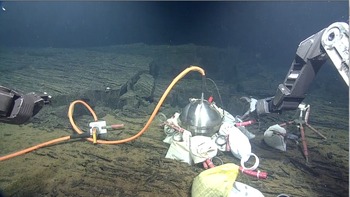
During ROPOS Dive R1840, the broadband seismometer at the MJ03F junction box at the Central Caldera site, as well as the adjacent surroundings were inspected to see if the site was impacted by the April 24 eruption. The water was quite cloudy around the site. Ten pea gravel bags were placed around the broadband instrument to better couple it to the seafloor. Credit: NSF-OOI/UW/ISS; V15.
Broadband seismometers measure seismicity/earthquake activity along tectonic plate boundaries where fundamental processes act to shape the face of our oceans: large-magnitude subduction zone earthquakes, localized earthquakes associated with faulting and spreading events along mid-ocean ridges and fracture zones, and seismicity due to migration of melt (magma) beneath underwater volcanoes. Over 70% of the volcanism on Earth occurs along mid-ocean ridges.
Five of these instruments are now installed on the Cabled Array, one each at Slope Base (PN1A), at the base of Axial Seamount (PN3A), and at Southern Hydrate Ridge where methane is venting from the seafloor. Two additional broadband seismometers are installed at the summit of Axial Seamount at the Eastern and Central Caldera sites.
The small array of broadband seismometers are installed to detect earthquakes along the subducation zone at the Cascadia Margin and at the highly active volcano - Axial Seamount. These instruments are also used to study smaller earthquakes associated with gas release, melt migration, and hydrothermal upflow. In sedimented areas (Slope Base, Southern Hydrate Ridge, and at the base of Axial Seamount), the seismometers are buried beneath the seafloor sediments in caissons to obtain the highest quality resolution of seismic waves.
At the summit of Axial Seamount, there is little sediment, and therefore the broadband seismometers were installed on basement rock, and surrounded by gavel-filled bags to dampen "noises" caused by currents at the summit of the volcano.
Because the seismometers are cabled and, hence, connected directly to shore, they provide detection of earthquakes in real-time with data transferred to shore at the speed of light.
During a 24 hr period April 24, 2015, >8,000 earthquakes were detected at the summit of Axial Seamount - indicating a seafloor eruption was occurring. Much larger arrays of cabled seismometers and pressure sensors are being utilized offshore in Japan to provide early warning dectection of seismic events such as the 9.0 magnitude megathrust Tohoku event and tsunamis (Dense OceanFloor Network System for Earthquakes and Tsunamis - DONET).
Instrument Specifics: The broadband seismometers are manufactured by Guralp, instrument model Guralp CMG-1T 360s-50Hz with CMG-5T Strong Motion, DM24/7-EAM Digitizer/Interface + Low Frequency Hydrophone (HTI-90-U). They have an Ethernet (10/100) interface, and are synced to pulse per second timing.
Sensors are in a Ti-housing and in sediment are buried in a 60 cm deep X 60 cm diameter caisson filled with silica beads, data are digitized.


